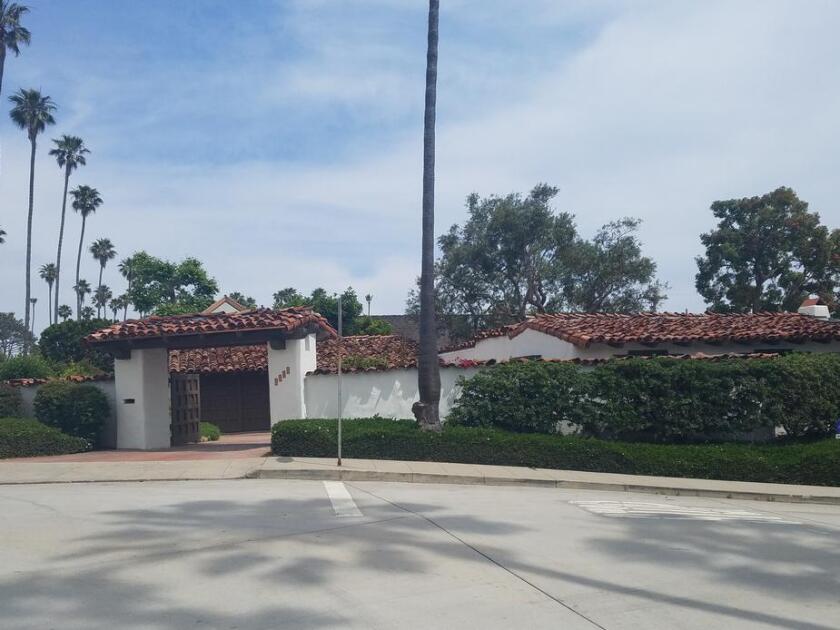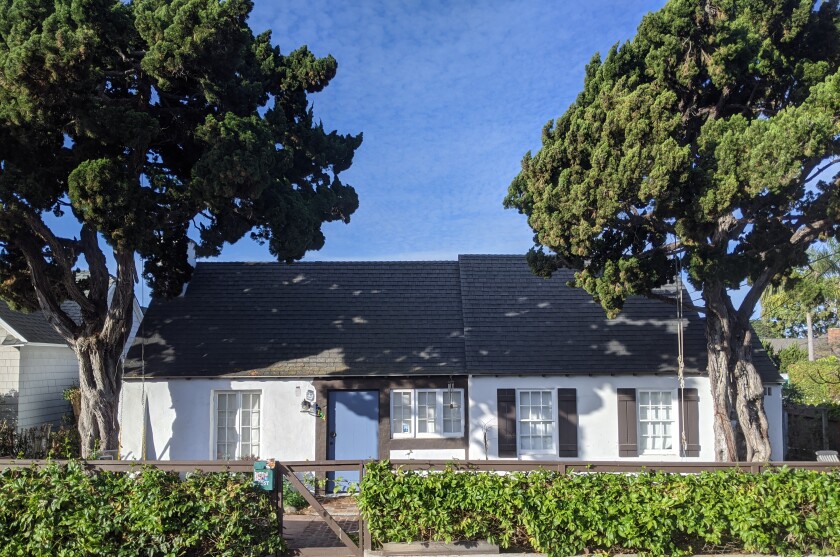The works and personal histories of Cliff May, Florence Palmer and Thomas Shepherd — names that could belong on the Mount Rushmore of La Jolla architecture — were spotlighted during a La Jolla Historical Society webinar March 31.
Speakers talked about the architects, their backgrounds and influences and significance to La Jolla’s history, along with local examples of their work, during the first of a two-part series. The second webinar will be Wednesday, April 14.
The first lecture focused on homes built before World War II, ranging from Spanish Eclectic to spec houses.
Thomas Shepherd
Speaking as the owner of a Shepherd-designed, historically designated house, La Jolla Landmarks Committee Chairwoman Seonaid McArthur talked about his work, not on her house but the Rev. Nassau and Estelle Stephens House on Amalfi Street.
McArthur said the San Diego Historical Resources Board has a set of criteria as to what makes a “landmark”: Is the site significant to the community’s overall development? Was a person or event associated with the site tied to history? Is it an outstanding example of style, design and craftsmanship? Is it the work of a master architect?
The Amalfi Street house meets many of the criteria, being built in the 1930s — “La Jolla’s building boom,” McArthur said — in Spanish-style architecture by master architect Shepherd. It is tucked into the hillside, inspired by homes tucked into the hillsides of Spain and France.
The house, now owned by Ann Craig, was designated historic by the HRB in June for its retention of character-defining features of the Spanish Eclectic style and for its connection to Shepherd.
McArthur said the house was built in the budding “California style” of “unique regional forms drawing upon the Spanish heritage of the missions, designed for the seaside and clarity of light.”
She discussed features of the house ranging from the decorative stucco to the tiles and the positioning of the house so the owners could watch the sunset.
Shepherd, a Wisconsin native, moved to La Jolla in 1926. While many architects left La Jolla during the Great Depression, he stayed and went on to work on more than 100 properties here, 19 of which have been historically designated.
“He was a gregarious and popular man, good with people and very active in the La Jolla community,” McArthur said.
When Shepherd and his wife died, they had no heirs and left money to local charities.
“I would say he is one of the most important architects and philanthropists in all of La Jolla history,” McArthur said.
Craig provided a video tour of the house, showing its signature features.
Cliff May
Born in San Diego with family ties to those who owned ranchos and farms, May spent many of his childhood summers at those ranchos and in their adobe houses. That would be one of the defining elements of his later design style, according to speaker Meredith Baratz, who delved into the local history of the man who would become known as the father of the California ranch house.
May made furniture during the Depression and learned the importance of craftsmanship, Baratz said. A local developer saw May’s furniture and put it in his show homes.
“The rapid sale of those show homes caused these developers to fund May’s own design and construction of houses in the 1930s,” she said.

The Cliff May-designed Col. OHB and Gladys Trenchard House is at 6126 Avenida Cresta in La Jolla.
(Courtesy)
Some of the dynamics that influenced May and his colleagues of the time, she said, were San Diego’s “Spanish aesthetic, an appreciation for the region’s natural beauty and climate, and the local craft and trade talent.”
Once May started designing and building houses, he made 50 in five years.
The key themes in his design included “following the topography in that his homes hugged and followed the lots they sat on, integrated indoor/outdoor space … and a rustic simplicity in design, construction and materials.”
And while his style evolved over the years to become “more sleek,” he stuck with the core principles of following topography, Baratz said.
May “rarely scraped a lot to build upon it, but rather had his house follow the lay of the land,” she said. He used false chimneys to mark changes in elevation, brought the outdoors in with U-shaped construction to create a courtyard and planted his signature olive trees on the property.
“There are several Cliff May homes in La Jolla’s early neighborhoods,” Baratz said. “May built four homes on a single block of Avenida Cresta in the 1930s. Two of these homes were historically designated in the last few years.”
Florence Palmer
After her divorce from her husband in the 1920s, architect Palmer went on to design a spec house (one built by the architect without an owner and sold right away) in La Jolla’s Barber Tract. It was one of her first properties on her own and was identified as “Florence Palmer Spec House No. 2.” The home on Olivetas Avenue was designated historic last year.

This renovated 1927 house at 7154 Olivetas Ave. in La Jolla is known as “Florence Palmer Spec House No. 2.”
(Courtesy)
Palmer, who learned the trade from her husband, also an architect, was one of four women working in architecture in 1920s San Diego and made “outstanding contributions to La Jolla’s built environment,” said speaker Vonn Marie May. Palmer was posthumously awarded the master designer title by the city of San Diego in 2015.
She specialized in Tudor Revival styles that were popular at the time, May said, and gave her houses “character-defining features such as one-story massing, an irregular floor plan, multiple steeply pitched gable roofs with flared eaves and exposed rafter tails.”
Last month, Amy Waterhouse and Ben Reineman, the owners of Florence Palmer Spec House No. 2, received the La Jolla Historical Society Jewel Award for historic restoration for their care in getting the house restored and designated historic.
The April 14 lecture will focus on Frederick Liebhardt, Sim Bruce Richards and Henry Hester and the post-World War II era. It will begin at 5 p.m. online. As with the first lecture, there will be an opportunity for the public to ask questions of the panelists, including about how to get a house designated. Learn more at lajollahistory.org. ◆
"may" - Google News
April 04, 2021 at 10:00PM
https://ift.tt/3ul0Vxt
La Jolla webinar recalls pre-WWII work of architects Cliff May, Thomas Shepherd and Florence Palmer - La Jolla Light
"may" - Google News
https://ift.tt/3foH8qu
https://ift.tt/2zNW3tO
Bagikan Berita Ini














0 Response to "La Jolla webinar recalls pre-WWII work of architects Cliff May, Thomas Shepherd and Florence Palmer - La Jolla Light"
Post a Comment